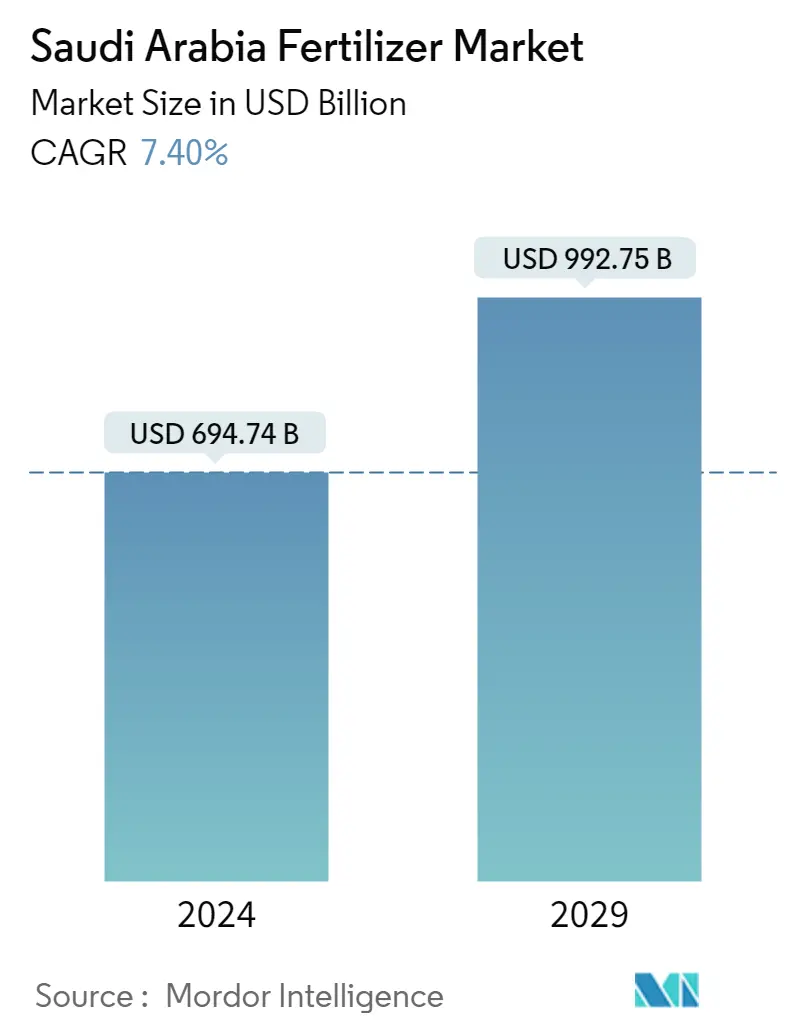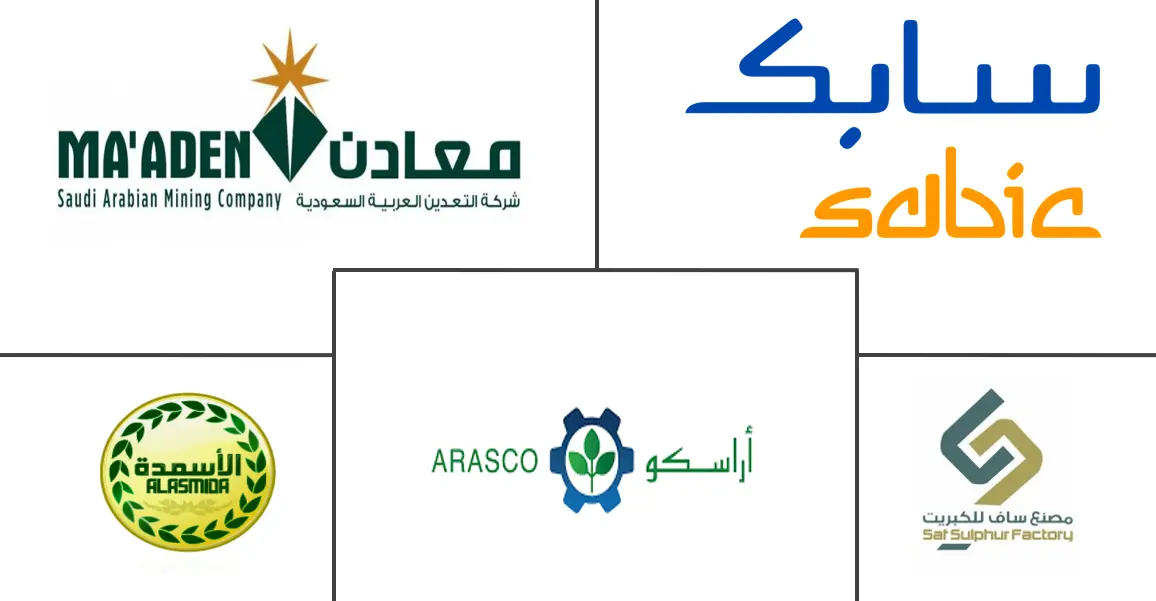Market Size of Saudi Arabia Fertilizer Industry

| Study Period | 2019 - 2029 |
| Base Year For Estimation | 2023 |
| Market Size (2024) | USD 694.74 Billion |
| Market Size (2029) | USD 992.75 Billion |
| CAGR (2024 - 2029) | 7.40 % |
| Market Concentration | Medium |
Major Players
*Disclaimer: Major Players sorted in no particular order |
Need a report that reflects how COVID-19 has impacted this market and its growth?
Saudi Arabia Fertilizer Market Analysis
The Saudi Arabia Fertilizer Market size is estimated at USD 694.74 billion in 2024, and is expected to reach USD 992.75 billion by 2029, growing at a CAGR of 7.40% during the forecast period (2024-2029).
The effects of COVID-19 were severe on the economy across the sectors of Saudi Arabia, resulting in a shortage of labor, temporary plant closures, and reduced operating rates across all the industrial sectors in the country. Even if factories have resumed their operation, there were issues regarding shipping and logistics. Thus, finding air, sea, or land freight was a major factor disrupting the companies involved in the industry. Higher costs of containers and shipping, hauling, and storage increased fertilizer prices.
Over the years, Saudi Arabia, a country that receives an average of just about four inches of rain every year, has aimed to develop its agricultural sector to achieve self-sufficiency in food security. Thus, the application of fertilizer to improve crop growth and yield is expected to become crucial, creating higher demand for fertilizer.
The effects of COVID-19 were severe on the economy across the sectors of Saudi Arabia, resulting in a shortage of labor, temporary plant closures, and reduced operating rates across all the industrial sectors in the country. Even if factories have resumed their operation, there were issues regarding shipping and logistics. Thus, finding air, sea, or land freight was a major factor disrupting the companies involved in the industry. Higher costs of containers and shipping, hauling, and storage increased fertilizer prices.
Although the nitrogenous fertilizer segment took the larger chunk of the market with the share of 39.3% in 2021, potassic fertilizer application is growing at a rapid rate, as it may enhance the plants' tolerance to abiotic stress, especially a lack of water, which may otherwise significantly reduce crop yields. Fruits and vegetable production has been growing in the country. The COVID-19 pandemic has emphasized the importance of developing local food sources. Thus, increased agricultural activity due to the government's various initiatives to achieve self-sufficiency is expected to drive the fertilizer market in the country over the forecast period.
Saudi Arabia Fertilizer Industry Segmentation
The International Fertilizer Association defines a fertilizer as 'any solid, liquid, or gaseous substance containing one or more plant nutrient in known amount, which is applied to the soil directly on plants, or as added aqueous solutions (as in fertigation), to maintain soil fertility, improve crop development, yield, and crop quality'.
The Saudi Arabia Fertilizers Market is segmented by Type (Nitrogenous Fertilizers, Phosphatic Fertilizers, Potassic Fertilizers, Secondary Fertilizers, and Micronutrient Fertilizers) and Crop Type (Grains and Cereals, Pulses and Oilseeds, Commercial Crops, Fruits and Vegetables, and Other Crop Types). The report offers the market sizes and forecasts in value (USD) for all the above segments.
| Type | ||||||||
| ||||||||
| ||||||||
| ||||||||
| Secondary Macronutrient Fertilizers | ||||||||
| Micronutrient Fertilizers |
| Application | |
| Grains and Cereals | |
| Pulses and Oilseeds | |
| Fruits and Vegetables | |
| Others Crop Type |
Saudi Arabia Fertilizer Market Size Summary
The Saudi Arabia Fertilizer Market is projected to experience significant growth over the forecast period. This growth is primarily due to the country's aim to develop its agricultural sector to achieve self-sufficiency in food security, thereby creating a higher demand for fertilizer. However, the industry faced severe disruptions due to the COVID-19 pandemic, including labor shortages, temporary plant closures, and logistic issues, leading to increased fertilizer prices. Despite these challenges, various fertilizer segments, particularly the nitrogenous fertilizer segment and potassic fertilizer application, are expected to drive the market. Saudi Arabia is a major player in the global fertilizer industry, being the largest ammonia exporter in the GCC region. The country enjoys a competitive advantage in supplying the Asia-Pacific region due to the availability of natural gas at attractive prices, enabling low-cost production. The focus on increasing exports, coupled with the government's initiatives to boost local food sources and agriculture, is expected to further fuel the growth of the Saudi Arabia Fertilizer Market. The market is moderately consolidated, with major players like Saudi Basic Industries Corporation (SABIC) and Maaden phosphate Co. leading the industry.
Explore MoreSaudi Arabia Fertilizer Market Size - Table of Contents
-
1. MARKET DYNAMICS
-
1.1 Market Overview
-
1.2 Market Drivers
-
1.3 Market Restraints
-
1.4 Porter's Five Forces Analysis
-
1.4.1 Bargaining Power of Suppliers
-
1.4.2 Bargaining Power of Buyers/Consumers
-
1.4.3 Threat of Substitute Products
-
1.4.4 Threat of New Entrants
-
1.4.5 Intensity Competitive Rivalry
-
-
-
2. MARKET SEGMENTATION
-
2.1 Type
-
2.1.1 Nitrogenous Fertilizers
-
2.1.1.1 Urea
-
2.1.1.2 Calcium Ammonium Nitrate
-
2.1.1.3 Ammonium Nitrate
-
2.1.1.4 Ammonium Sulfate
-
2.1.1.5 Anhydrous Ammonia
-
2.1.1.6 Other Nitrogenous Fertilizers
-
-
2.1.2 Phosphatic Fertilizers
-
2.1.2.1 Mono-ammonium Phosphate (MAP)
-
2.1.2.2 Di-ammonium Phosphate (DAP)
-
2.1.2.3 Single Super Phosphate (SSP)
-
2.1.2.4 Triple Super Phosphate (TSP)
-
2.1.2.5 Other Phosphatic Fertilizers
-
-
2.1.3 Potassic Fertilizers
-
2.1.3.1 Muriate of Potash (MOP)
-
2.1.3.2 Sulfate of Potash (SOP)
-
-
2.1.4 Secondary Macronutrient Fertilizers
-
2.1.5 Micronutrient Fertilizers
-
-
2.2 Application
-
2.2.1 Grains and Cereals
-
2.2.2 Pulses and Oilseeds
-
2.2.3 Fruits and Vegetables
-
2.2.4 Others Crop Type
-
-
Saudi Arabia Fertilizer Market Size FAQs
How big is the Saudi Arabia Fertilizer Market?
The Saudi Arabia Fertilizer Market size is expected to reach USD 694.74 billion in 2024 and grow at a CAGR of 7.40% to reach USD 992.75 billion by 2029.
What is the current Saudi Arabia Fertilizer Market size?
In 2024, the Saudi Arabia Fertilizer Market size is expected to reach USD 694.74 billion.
